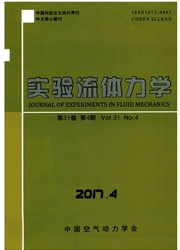

 中文摘要:
中文摘要:
开展了三维暂冲式激波聚焦及起爆爆震的冷态与热态实验,并采用WENO算法和块结构网格自适应加密算法进行了高精度数值模拟。在环形喷口宽度d=5.4mm,驱动压力Pres=0.55MPa,初始压力Pinit=0.091MPa的条件下,第1次激波聚焦所致的峰值压力达2.17MPa,是初始压力的23.8倍。以当量比1.0的C2H2/Air混合气为工质,在驱动压力为1.51MPa,环形喷口宽度d=11.4mm的工况下成功起爆了爆震波。测得火焰传播速度与激波传播速度之间的耦合偏差为2.7%,爆震波速为1587.3m/s。数值模拟清晰地捕捉到了激波聚焦及起爆爆震过程中的流场演化细节。发现环形激波沿三维凹面腔径向入射,首先在对称轴上聚心碰撞,形成沿对称轴对称分布的马赫干,并作为入射激波向凹面腔底部推进。同时,原入射激波也向凹面腔底部运动。因此,环形激波沿三维凹面腔径向入射聚焦的完成是以原人射激波和新形成的马赫干在凹面腔底部碰撞为标志的。
 英文摘要:
英文摘要:
Cold and thermal state experiments for 3D blow-down shock focus and induced detonation were performed. In the meantime, corresponding numerical simulations were carried out using the adaptive mesh refinement and WENO method. The peak pressure of the first shock focus at the bottom of the cavity reached 2.17MPa, that is 23.8 times the amplitude of the initial pressure Pleat ~-0. 091MPa, when the width of annular nozzle was d= 5.4mm and the driving pressure was Pret=0.55MPa, Thermal state experiments were performed using C2 H2/Air mixture at equivalence ratio of 1.0. Detonation was obtained through shock focus when the driving pressure was 1.51MPa and the annular nozzle width was 11.4ram. The relative error between the velocity of the leading shock and that of the flame was 2.7%, and the detonation velocity was 1587.3m/s. In the numerical simulation, the details of the flow field evolution were captured. It is found that the annular shock first implodes along the axis and produces axisymmetric Mach stems. Then, the axisymmetrie Mach stems and the initial incident shock propagate towards the cavity bottom simultaneously. At last, the new formed axisymmetric Mach stems and the initial incident shock col- lide at the cavity bottom, characterizing the completion of the shock focus.
 同期刊论文项目
同期刊论文项目
 同项目期刊论文
同项目期刊论文
 期刊信息
期刊信息
